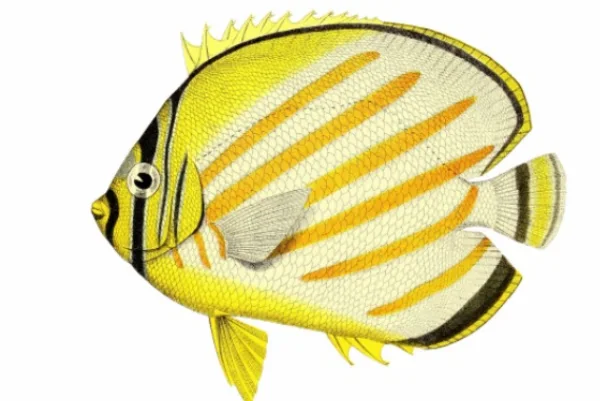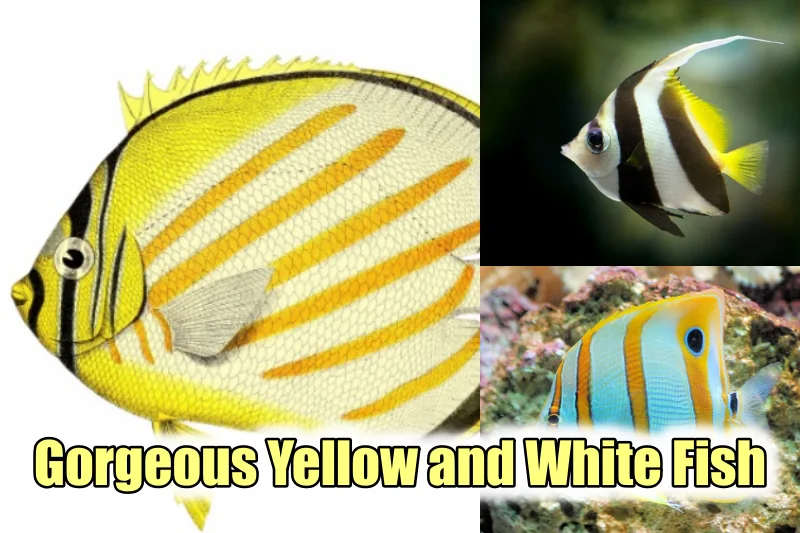The large ocean has millions of creatures in it. Some are beautiful and some are horrible. One of the common aquatic animal we all know is fish. But you might not know there are thousands of species of fish.
Most of us don’t even imagine about those species of fishes, even there color. As bright as sun ocean has some beautiful yellow and white fish. And today we are going to dive into the ocean to know about the yellow and white fish. So let’s go!
14 Yellow And White Fish
1. Copperband butterfly fish

| Scientific Name | Chelmon rostratus |
| Diet | benthic invertebrates, glass anemones or Aiptasia, polychaete tube worms, small crustaceans |
| Size | 20 cm |
| Geographical location | Pacific and Indian Ocean |
The copperband butterflyfish (Chelmon rostratus) is a species in the Chelmon genus with long beaks and yellow banding. This yellow and white fish also known as the beaked coral fish. It grows up to 20 cm in length and has a compressed, deep-bodied form with long dorsal and posterior fins.
The snout is long and slender, and the dark eye is less conspicuous than the dorsal fin’s dark eye spot. The base of the tail features a dark band that runs perpendicular to the tail.
2. Pyramid Butterfly fish

| Scientific name | Hemitaurichthys polylepis |
| Diet | Planktons |
| Size | 18 cm |
| Georgaphical Location | Indo-Pacific, Christmas Island, Polynesia, south Japan, and New-Caledonia |
The pyramid butterflyfish is native to the central Indo-Pacific and can reach a maximum length of 18 cm. Its body has a rounded profile, and its snout protrudes forward slightly.
The fish’s characteristic livery includes a dark brown-yellow area, covering the head and extending to the dorsal fin and pelvic fins. The rest of the body is white, with yellow-orange areas at the top of the side forming a pyramidal pattern, forming the fish’s name.
3. Moorish idol

| Scientific name | Zanclus cornutus |
| Diet | corals, sponges, tunicates and other benthic invertebrates |
| Size | 21-23 cm |
| Georgaphical Location | Indo-Pacific, East Africa, and Pacific coasts of the tropical Americas |
The Moorish idol is a marine ray-finned fish. Found on Indo-Pacific reefs. Its has compressed and disc-like body. This fish has a tube-like snout and small bony protruberances above the eyes.
The dorsal fin has 6 or 7 spines. And its anal fin contains 3 spines and between 31 and 37 soft rays. The fin has a white background color, two wide black vertical bands, a yellow patch on the posterior end, and a yellow saddle on the snout. The caudal fin is black with a white margin.
4. Yellowfin goatfish
| Scientific name | Mulloidichthys vanicolensis |
| Diet | worms and small crustaceans |
| Size | 38 cm |
| Georgaphical Location | Indo-Pacific, Red Sea, Hawaii, Tuamotus, Japan and Lord Howe Island |
The yellowfin goatfish, also known as the golden banded goatfish or goldstripe goatfish, has a streamlined shape with a bright yellow-gold upper body and dorsal and caudal fins.
The lower body is silver gray, with a bright gold horizontal stripe across the midbody. The scales the stripe are lightly flecked in blue. The anal and pelvic fins are yellow.
M. vanicolensis can grow up to 38 cm in length, with a red-orange back, whitish flanks, a yellow belly, and yellow fins. It feeds on crustaceans or worms at night and forms large aggregations by day.
5. Yellowhead butterfly fish

| Scientific name | Chaetodon xanthocephalus |
| Diet | algae and seaweed, worms, small crustaceans and zooplankton |
| Size | 20 cm |
| Geographical location | South Africa, Madagascar, India and Sri Lanka |
Chaetodon xanthocephalus is a marine fish in the Chaetodontidae family found in the Indian Ocean. This yellow and white fish also known as the yellowhead butterflyfish.
Its pearly white body has a golden-yellow band on the head, dorsal and ventral parts, and fins, with greyish blue chevrons. The eyes have a black vertical bar and a thin yellow line on the operculum.
The orange dorsal and anal fins have light black marks and yellow margins. The caudal fin is light gray and edged in yellow. The yellowhead butterflyfish can reach a maximum length of 20 centimeters.
6. Teardrop butterflyfish
| Scientific name | Chaetodon unimaculatus |
| Diet | hard-soft corals, marine invertebrates, and filamentous algae |
| Size | 16-20 cm |
| Geographical location | Indian, western Pacific Oceans, Christmas Island, Hawaii, the Marquesas and Ducie Island, Japan, Tasman Sea, and the central coast of New South Wales |
The teardrop butterflyfish is a marine ray-finned fish in the Chaetodontidae family, found in the Indo-Pacific region. Its whitish body has yellow dorsal, anal, and pelvic fins, with a large teardrop-shaped black blotch on the upper flank.
The dorsal fin contains 12–13 spines and 19–23 soft rays, while the anal fin contains 3 spines and 18–20 soft rays. The maximum length of this species is 20 centimeters, but it is more common at around 16 centimeters.
7. Ornate butterflyfish

| Scientific name | Chaetodon ornatissimus |
| Diet | meaty foods, algae |
| Size | 13-18 cm |
| Geographical location | Sri Lanka, Hawaii, the Marquesas, the Pitcairn Islands, Japan, Lord Howe, and the Austral Islands |
Ornate butterflyfish, also known as clown butterfyfish, is a marine ray-finned butterflyfish in the Chaetodontidae family. Its color pattern protects it from predators.
Ornate butterflyfish have white bodies with orange-brown oblique bands, yellow-edged black bars on their heads, and black bars on their tail. They range in size from 13–18 cm in total length.
8. Yellow longnose butterfly
| Scientific name | Forcipiger flavissimus |
| Diet | invertebrates including stony coral polyps and soft coral polyps as well as small animal prey including crustaceans |
| Size | 22 cm |
| Geographical location | Indo-Pacific area, Africa, Hawaii, Red Sea included, Baja California, Revillagigedo Islands, and the Galapagos |
The yellow longnose butterflyfish is a marine fish found in tropical waters of the Indo-Pacific region. This yellow and white fish is also known as a forceps butterflyfish.
It grows up to 22 cm in length and has a disc-like body with a long, protruding snout and a small mouth. The yellow longnose butterflyfish has a bright yellow body, yellow dorsal, anal, and pelvic fins, and a black bar over the nape.
The name “forceps” comes from the Latin forcipiger, meaning “forceps bearing. Both species use their elongated mouths to pluck invertebrate prey from coral reef crevices.
The yellow longnose butterflyfish has 12 spines and 22–24 soft rays, while the big longnose butterflyfish has 12 spines and 25–28 soft rays.
9. Ribboned sweeltips fish
| Scientific name | Plectorhinchus polytaenia |
| Diet | crustaceans, gastropods or annelids, and smaller fishes |
| Size | 50 cm |
| Geographical location | Indo-Pacific region, India, Malay Archipelago, the Philippines, New Guinea, Solomon Islands, and Australia |
Plectorhinchus polytaenia is a marine ray-finned fish native to the Indian Ocean and western Pacific Ocean. This yellow and white fish also known as Tesone di mare or yellow-ribbon sweetlips.
Its fleshy lips become moderately swollen as the fish ages, and it has 6 pores on its chin. The dorsal fin contains 12-13 spines and 19-22 soft rays, while the anal fin has 3 spines and 7-8 soft rays.
The fins are yellow with darker stripes on the soft-rayed part, fade with age, and have yellowish eyes and lips. Juveniles have less stripes on their orange-brown bodies, with a central black band.
10. Japanese swallow
| Scientific name | Genicanthus semifasciatus |
| Diet | meaty foods, algae, |
| Size | 21 cm |
| Geographical location | southern Japan, the Ogasawara Islands, the Izu Islands, the Ryukyu Islands, and northern Philippines |
Genicanthus semifasciatus, the Japanese swallow, is a marine ray-finned fish found in the Western Pacific. It is sexually dichromatic, with males having a yellow head and anterior flanks and females having a greyish brown and white ventrally.
The dorsal fin contains 15 spines and 15–16 soft rays, while the anal fin has 3 spines and 17 soft rays. The head and tail are black. The species attains a maximum total length of 21 centimeters.
11. Barred angelfish
| Scientific name | Paracentropyge multifasciata |
| Diet | Chopped mussels, oysters, mysis and brine shrimps |
| Size | ~12 cm |
| Geographical location | Australia, French Polynesia, Japan and south to the Great Barrier Reef of Queensland |
Paracentropyge multifasciata is a marine ray-finned fish species native to the Indo-Pacific. It has a white background with 8 black vertical bars, which change color to yellowish as they approach the ventral part of the body.
The dorsal fin has 13 spines and 17-19 soft rays, while the anal fin has 3 spines and 17-18 soft rays. The fish has a yellow mouth, pelvic and anal fin, and a hyaline caudal fin with black spots. Juveniles have less distinct bands.
12. Saddled Grouper
| Scientific name | Plectropomus laevis |
| Diet | Fishes and crustaceans |
| Size | ~125 cm |
| Geographical location | Australia, French Polynesia, Japan and south to the Great Barrier Reef of Queensland |
Plectropomus laevis, also known as the black-saddled coral grouper, is a marine ray-finned fish found in the Indo-Pacific region.
It has an elongate, robust body. The preopercle is rounded with three large spines, while the dorsal and anal fins contain 7-8 spines and 10-12 soft rays.
The caudal fin is truncate. Plectropomus laevis has two color phases: the “footballer phase” with black saddles and yellow fins, and the greyish form with a dark head and small blue spots.
Juveniles are Batesian mimics of the toxic Valentin’s sharpnose puffer. The species can reach a total length of 125 centimetres and a maximum weight of 24.2 kilograms.
13. Yellowface Angelfish
| Scientific name | Pomacanthus xanthometopon |
| Diet | Sponges, algae, and encrusting organisms |
| Size | ~38 cm |
| Geographical location | Australia, French Polynesia, Japan and south to the Great Barrier Reef of Queensland |
Pomacanthus xanthometopon is a marine angelfish, also known as the blueface or yellowface angelfish, found in shallow parts of the Indo-Pacific.
This species of yellow and white fish can grow up to 38 centimetres. The fins are large, rounded, and yellow, with some edged with blue.
The dorsal fin has a distinctive black eyespot and 13-14 spines and 16-18 soft rays. The anal fin has 3 spines and 16-18 soft rays. The scales are pale blue edged with yellow, and the face is yellow with brilliant blue lines and a plain yellow mask around the eyes.
Juveniles are different, with 6 vertical white bars separated by pale blue lines and a caudal fin barred in two shades of blue.
14. Pearlscale angelfish
| Scientific name | Centropyge vrolikii |
| Diet | Algae and sponge |
| Size | ~12 cm |
| Geographical location | Indo-pacific region |
Centropyge vrolikii, also known as the pearlscale angelfish or half black angelfish, is a marine ray-finned fish found in the Indo-Pacific.
It has a pale greyish to brownish body with whitish scale centers that darken to black towards the tail. The species has a maximum total length of 12 centimetres (4.7 in) and has orange gill slits and base of pectoral fin.
Conclusion:
These are some species of yellow and white fish. We bet most of us don’t know about before this. These beautiful yellow and white fish looks to enthusiastic. This is it for today, we will be back with some more informative article. Keep looking for it with us on How It See.
Also Read:

As a content writer, I like to write about different niches. I have a curiosity about nature and animals. And like to learn about them. Through my writing, I like to share my experience and knowledge with you. I hope you are enjoying it too.

